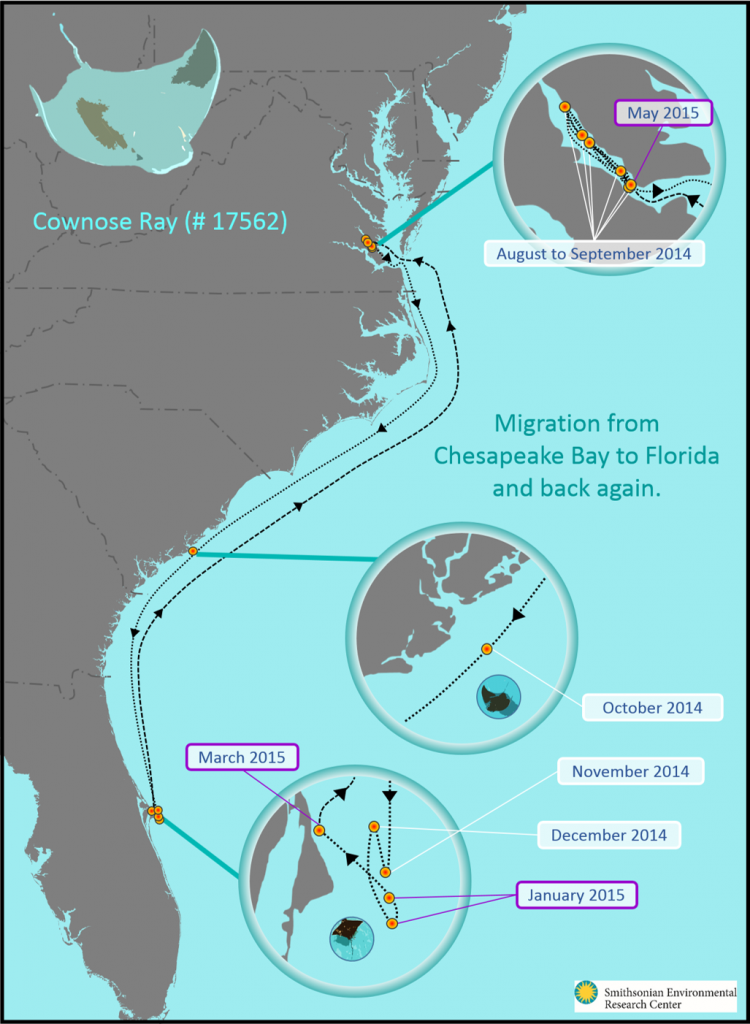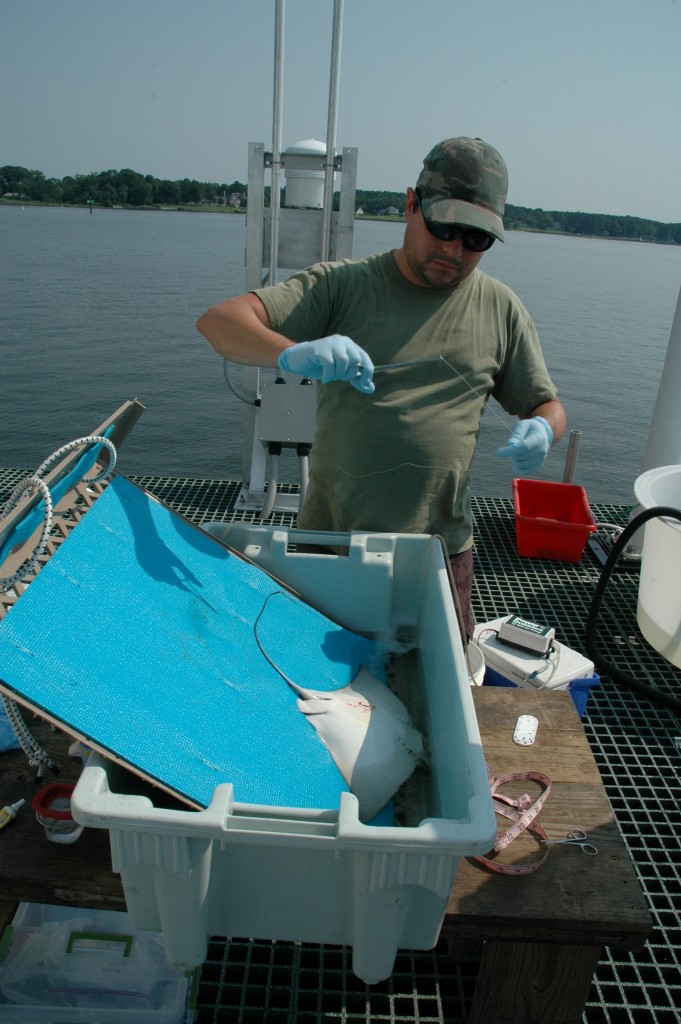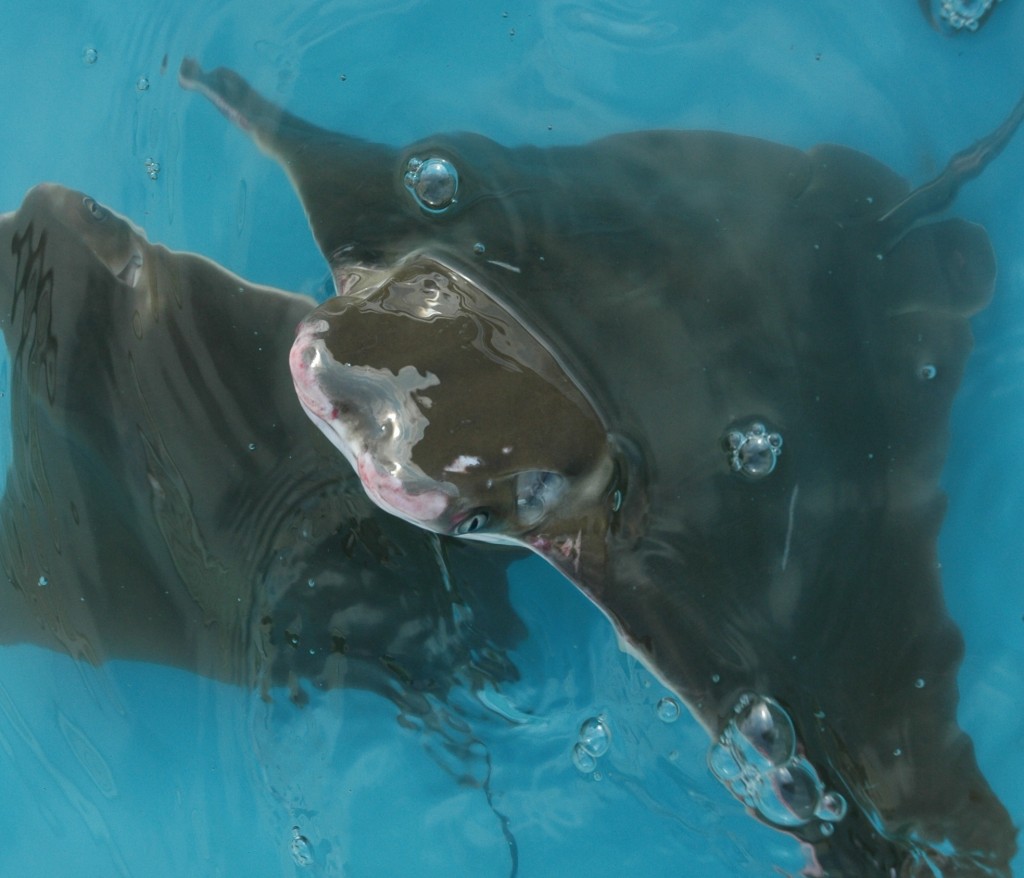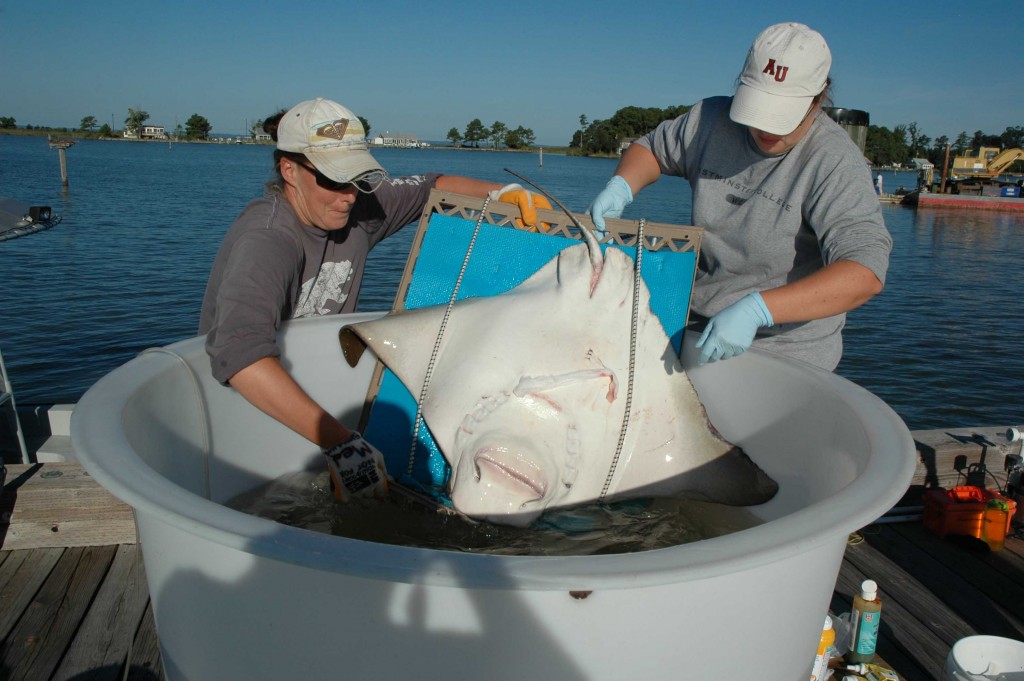by Chris Patrick
It’s 2 a.m. Rob Aguilar, biologist in the Smithsonian Environmental Research Center’s (SERC) Fish and Invertebrate Ecology Lab, meets a group of fishermen at a pound net in the Patuxent River. The net starts at the shore and juts far into the river. Fish traveling along the shore collide with the net and follow its length into a heart-shaped net at the end—the pound.
Today, the pound contains cownose rays. Not ideal for fishermen, but exactly what Aguilar wants. Last summer SERC researchers and collaborators surgically implanted acoustic tags in 31 rays to track their migration. This summer, they’re tagging 20 to 25 more rays from Maryland rivers.
Though native to the East and Gulf Coasts, much about cownose rays remains mysterious. Many fishermen and oyster growers consider rays a nuisance because they eat shellfish and travel in schools in the hundreds.
“The main conflict seems to be between guys who fish for oysters—especially aquaculture oysters because there’s a lot of money in that—and these rays they perceive as potentially eating up their profits,” says Matthew Ogburn, ecologist in the Fish and Invertebrate Ecology Lab.
Those who see rays as profit-gobblers want fewer around. Some have attempted to establish commercial fisheries, and ray fishing tournaments are growing in popularity. Tournament organizers argue they’re helping maintain populations at a healthy level, but conservation groups are concerned because rays reproduce slowly. Females give birth to only one pup per year.
Amidst this conflict, SERC researchers are studying ray migration to determine if Chesapeake rays belong to a local, regional, or coast-wide population. Their discoveries could help decide whether rays are ultimately managed as pests or creatures to protect.
Rays in Chesapeake rivers could belong to local populations, each returning to a specific river every year. Or they might be part of a larger regional population that returns to the Bay annually and wanders around. Or they may be part of an East Coast population that visits the Bay one year and another East Coast estuary the next.
“If someone comes and has a big fishing tournament here and nails a bunch of the rays here, if it’s a coast-wide population that probably has a small impact,” says Ogburn. “If it’s a local population, you could wipe out the local population really quickly.”
To tag rays, SERC researchers meet fishermen before dawn and transfer captured rays to an aerated kiddie pool.
“They’re adorable,” says Corey Corrick, SERC graduate research assistant. “They’re gentle little guys.”
Though cute, rays have barbed stingers at the base of their tails. The researchers wear wristguards and puncture-resistant gloves (the kind usually worn by power line workers) for protection while transferring a ray from the kiddie pool to a smaller tub of anesthetic to knock them out before surgery.
Using bungee cords, they secure the now-sedated ray to a plastic bread crate with the edges cut off—the operating table. Aguilar slices open the ray’s belly, inserts a tag resembling a mini Tootsie Roll (a really expensive Tootsie Roll), and sews the ray up. The patient is released after recovering for about 30 minutes.
Every two minutes, the tags make seven clicks encoding a number unique to each ray. When a ray is in range of a receiver, about half a mile, the receiver logs that it heard that ray’s number. There are several hundred receivers along the East Coast, and the organizations running them all share data with each other.

SERC researchers tagged Cownose Ray #17562 in Chesapeake Bay during the summer of 2014. They tracked its winter migration to Florida and return this summer to the same location in Chesapeake Bay. (SERC)
Cownose rays live in the Bay and other East Coast estuaries, but migrate to Florida come winter. This past winter, receivers in Florida recorded hearing half the rays tagged last summer. “Probably the ones that we didn’t hear back from were in Florida,” says Ogburn. “They just didn’t happen to swim near the receiver.” They’ve heard back from all but one of the 31 rays somewhere along the East Coast.
Last summer, SERC researchers mostly tagged rays caught in Virginia with the help of Bob Fisher, fisheries specialist at Virginia Institute of Marine Science (VIMS). Four rays tagged and released from the VIMS pier in the York River last summer were recently heard back at the VIMS pier this summer, suggesting these rays returned to the same place they were the summer before.
If this pattern continues, it may suggest the rays belong to regional or river-specific local populations, whose numbers could be more vulnerable. But for now, the team is listening for short clicks beneath the water, the sound of another creature returning on a long journey north.





Does anyone really understand the linked ecosystems of the Bay and what it will take to bring it back to health ?
Now the GOP wants to widen and build more roads with ensuing water runoff & ancillary development being not that much different than we have today.
Road Tax + Rain Tax
Thank all of you for what you do for those who can’t speak for themselves ! I am a Beach Steward at Delnor-Wiggins Pass State Park in Naples,Fla & was fasinated watching these beautiful creatures swimming along the edge of the water in schools. Everyone on the beach wanted to know if it was safe to swim in the Gulf I said yes they are small moving along feeding We love reading articles such as yours to learn & understand more about our oceans, bays, rivers, lakes, & gulf. Very grateful for your work
I appreciate the information in this article. We live in Maryland on the South Side of the West River a tidal estuary of The Chesapeake Bay . Early ever Summer since we moved here 16 years ago, the Rays showed up in front of our house. I grew up in South and Central Florida and was an avid Surfer,Fisherman,& Diver.I had seen the Clown nosed Rays many times I never knew they had such a great range.
When I first noticed them I had no Idea what they were. I though the were a pod of young Dolphins or Sharks.When they move in shallow water they keep their wing tips up and appear to have dorsal fins as the swim through the water.
They seem to come to our part of the river to mate. When they begin to mate in the shallow waters of this river they flop all around. The first time we heard these sounds it sounded as if a person or body was being thrown off a pier! The sounds of the Rays mating were loud and carried along way over the water in front of our House.
Wow great info on rays !!!
Please keep me informed and up to date.
I dive and photograph manta rays in Kona,hawaii.
Am interested in keeping track of these rays as well…Maxine, padi instruc